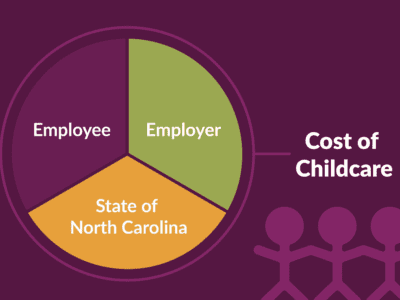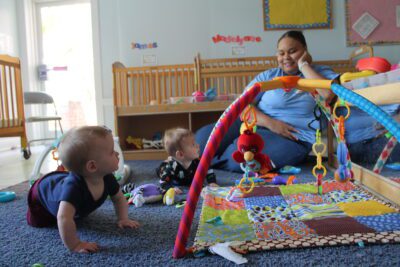
State lawmakers passed legislation this week to change child care regulations with a stated goal of expanding child care access by reducing costs for providers. The bill heads to the governor for his signature.
“Most of these provisions allow for flexibilities and reforms that are aimed at either staffing or property, because these are the two biggest cost drivers in the child care business and the primary barriers to expanding child care,” said Sen. Jim Burgin, R-Harnett, co-chair of the bill’s conference committee, on the Senate floor Wednesday.
![]() Sign up for Early Bird, our newsletter on all things early childhood.
Sign up for Early Bird, our newsletter on all things early childhood.
If signed by Gov. Josh Stein, the legislation will loosen staffing requirements for licensed programs, relax credential requirements for teachers, and launch a plan to decouple quality ratings from subsidy funding, among other items.
A 2020 analysis found no correlation between state regulations, including teacher requirements, and child care supply. It argued instead for public investment. Advocates have asked for increased state funding this session to help fill the gap between the costs of providing high-quality care and the rates families can afford.
The legislation passed this week, House Bill 412, does not include funding. Rep. Dean Arp, R-Union, co-chair of the bill’s conference committee, said he does not expect new state funding for child care to come out of this session.
“I don’t see that currently there is an opportunity to solve any part of these child care issues that we’re having by being able to pour significantly more money into it,” Arp said in an interview with EdNC. “There’s just such a competition for state salaries, teacher salaries, school investments, health care needs, and energy, and things of that nature.”
More on child care this session



The mini budget bills that lawmakers proposed this week in lieu of a new budget ahead of the end of the fiscal year did not include new child care funding.
Arp said the state’s role is to regulate and make the best use of federal funding from the Child Care and Development Fund (CCDF), which the states use to help low-income families afford child care and to improve its quality.
Employers also have a responsibility to provide benefits that help them recruit and retain workers, he said. Child care access matters, Arp said, because parents need it in order to work.
“It’s part and parcel to our overall economic development and workforce initiatives across the state,” he said. “People need to make sure that their children are taken care of in a safe place for them to be able to be in the job market.”
More on child care and employers



Tweaks to teacher requirements
The conference report on HB 412 combines policies in multiple pieces of legislation introduced during this session. While speaking on the conference report on the Senate floor Wednesday, Burgin thanked the North Carolina Licensed Child Care Association, the North Carolina Alliance of YMCAs, family child care home providers, and the NC Chamber for providing input to the bill.
The bill allows a lead teacher in a licensed program to supervise two groups of children instead of one, lowering the number of people with lead teacher credentials that programs must hire to meet certain quality standards.
The required child-to-adult ratios would remain the same, meaning other staff members without lead teacher credentials would be allowed to staff those classrooms instead. The bill also says that, in the case of a lead teacher supervising two groups, at least one other staff member overseeing the group must be working toward a lead teacher credential.
Programs have been struggling to recruit and retain qualified staff because they can’t pay competitive wages without pricing out families. The average hourly wage for child care workers was $14.20 in May 2023. The average annual price for families for center-based infant care was $12,251.
The bill also allows five years of experience in a licensed program to equate to the lead teacher credential. Individuals have been able to earn the NC Early Childhood Credential by completing one community college course or holding a nationally recognized credential such as the Child Development Associate (CDA), among other avenues.
“It was all about, in many cases, how do we expand lead teacher supply?” Arp said.
More on child care quality, access



Removing quality from funding considerations
The bill also tasks the Division of Child Development and Early Education (DCDEE) with submitting a proposed plan to legislators by May 1, 2026, to remove quality ratings as a factor in subsidy reimbursement rates.
Licensed child care programs receive quality ratings of one to five stars in the state’s Quality Rating and Improvement System (QRIS). These ratings factor into how much licensed programs receive per child to participate in the subsidy program, which helps low-income working families afford care through mostly federal funding. Those rates also depend on the age of the child and the location of the program. They are set through market rate studies that ask providers what they charge parents. The rates cover about half of the cost of providing care, according to DCDEE.
Arp said decoupling quality ratings from the rates is part of an effort to see how to most effectively spend federal dollars.
“How much is our current system costing us?” Arp said. “Is there another way to do it?”
The bill also increases maximum group sizes while maintaining the same child-to-staff ratios and space constraints.

Removing family child care barriers, studying insurance and licensure
The bill directs DCDEE, in consultation with the community college system, to create a School Age/Out-of-School Care Credential that aligns with both a new continuing education and curriculum course titled “Introduction to School Age Care and Education.”
It directs DCDEE to award family child care providers with either the North Carolina Early Childhood Administration Credential or the North Carolina Family Child Care Credential if they have completed certain continuing education courses that are equivalent to the required curriculum courses. Equivalency would be determined by the community college system, the bill states.
Family child care programs are licensed facilities in providers’ residences. The bill establishes a classification for these types of child care programs in the state building code. Providers advocated for this change after facing barriers in the state code to enroll more children.
Arp said the state should continue to increase options for families outside of child care centers.
“More and more people feel comfortable with someone in their neighborhood that they know,” he said.
More on family child care



The bill also allows family child care programs to operate without state licenses if they have certificates from the U.S. Department of Defense (DOD) or the United States Coast Guard, are only providing child care to children eligible for military child care, and meet certain state building safety provisions.
The bill directs the Commissioner of the Department of Insurance to create a work group to study affordable insurance options for child care providers. Liability insurance costs for child care providers have risen considerably in recent years, according to 2024 survey results from the National Association for the Education of Young Children.
The bill also directs DCDEE to create a Licensed Childcare Licensure Workgroup to study streamlining regulations on “the physical structures of licensed child care facilities, including building codes, fire codes, and sanitation codes.” It says the group shall resolve conflicts “between various code requirements for licensed child care facilities.”
Recommended reading



